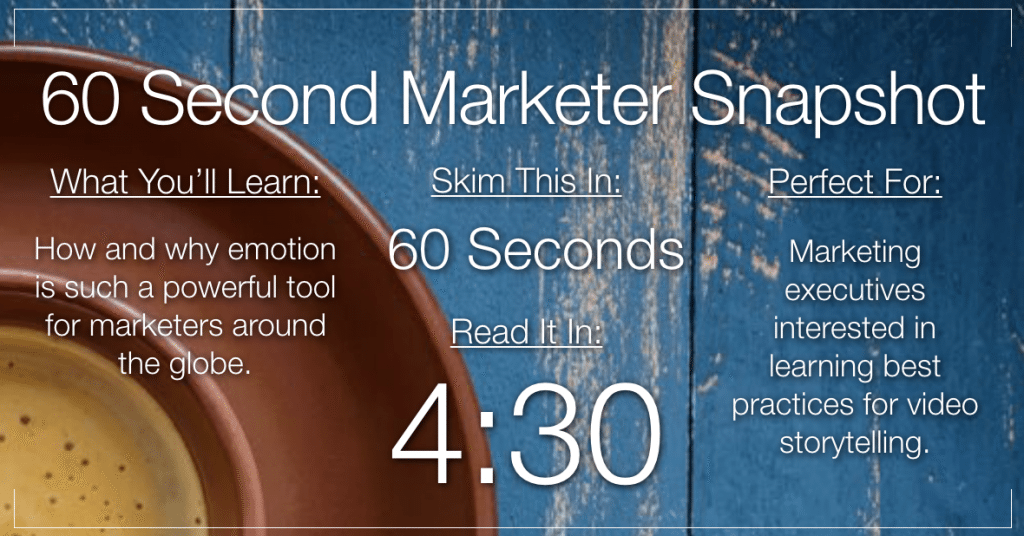
Most purchases are emotional decisions, subsequently rationalized.
The above statement is something of a mantra amongst advertising execs, and eliciting an emotional response from consumers is their holy grail. Emotional connection fuels viral campaigns, promotes brand loyalties and drives sales. Connect the dots, watch the dominoes tumble. This just leaves the sticky question of how, exactly, a brand sets about winning hearts.
The power of the story
In The Dream Society, a ground-breaking manual for millennial marketers, Rolf Jensen describes the historical shift from industrial and information ages, to a dream culture where value is now driven by meaning, via storytelling.
In an age where the material and informational needs of affluent consumers are broadly met, brands need to fire consumer desire by connecting with identity more existentially, addressing key themes such as adventure (how can my life seem bigger?), conviction (what do I believe in?) and community (who am I, what am I a part of?).
If a brand can tell a story which adds a dimension to, or meaningfully encapsulates, any or several of these themes, it stands an excellent chance of winning consumer fidelity.
The power of the medium
We’ve looked at the message, but what about the medium? In The Science Behind Why Video Works, Emily Ross provides a convincing argument for film as the ideal emotional storytelling medium.
Images are processed sixty-thousand times faster than text; 90 percent of information is received visually; two-thirds of consumers identify as visual learners and, as a result of all of these, film is 12 times more likely to be watched than text is to be read.
In the 60SecondMarketer article, Why You Can’t Afford to Ignore Video Advertising Anymore, the increasing ubiquity of video as a marketing tool is further explored.
However, it’s about more than scale of audience and ease and speed of receptivity. Images elicit emotional responses more effectively than words, acting as a trigger for the release of oxytocin, which enables empathy and builds trust and, ultimately, allegiance.
Stories that work
The following are three classic examples of brand storytelling in the medium of film. All three went viral because they tell emotional stories that resonate with consumers, who were then inspired to share the content because the messages reveal something important about their own lives, speaking on a much deeper level than traditional ‘buy this because it’s better’ advertising.
Google – Dear Sophie
Google’s 2011 Dear Sophie ad was a pioneer of emotional storytelling. Showing a father using the Google Chrome browser to create a memory book for his daughter, at a stroke Google branded itself as both cutting-edge technology and a conduit for shared emotions and experiences.
Unsurprisingly, this ad was a phenomenon with over ten million online views. It exploded onto social media with over half a million Facebook shares, creating a compelling, integrated, media experience. The ad features no traditional call to action, but an implicit emotional promise, conveyed with a subtlety of tone difficult to achieve in text.
Coca-Cola – Make It Happy
Coca-Cola’s 2015 Make It Happy campaign was a call to promote positivity in both the real and virtual worlds. The ad focused on our power to turn around online negativity, sending out an entirely positive image of solidarity and community, perfectly attuned to the history of the brand.
The combination of upbeat message and sense of collective responsibility played out brilliantly on social media, bolstered by its #MakeItHappy hashtag and the product line of selfie-friendly personalized bottles. Again, with no explicit call to action, the company positioned itself as a vehicle for optimism and change.
Sport England – This Girl Can
Sport England’s 2015 campaign was a simple montage of ordinary women demonstrating, in turn, extraordinary passion, commitment, team spirit and humor, as an encouragement to increase female participation in sport.
The juxtaposition of everyday settings and humble achievements with the heroic commitment of the participants, underscored by a catchy beat, worked fantastically well. It was a reminder for all of us to value ourselves, our dreams and ambitions, regardless of self-consciousness or prejudice.
The hashtag #ThisGirlCan was tweeted 660,000 times and the video attracted 37 million views in its first year.
So if your brand can crack the nut of eliciting an emotional response, it’s highly likely that you’ll gain more respect and extend your reach far wider than if you were to rely on traditional marketing messages that purely shout about the specific benefits of your products. For further insight, please download our video marketing white paper.
Jon Mowat is the Managing Director of international video production agency Hurricane Media, helping global brands connect with consumers.
Source:
https://60secondmarketer.com/blog/2016/05/22/create-emotional-connections-audience/amp/
